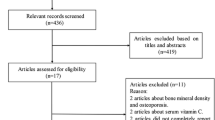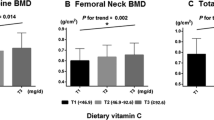Abstract
Data on the association between dietary vitamin K intake and fracture risk are limited among Chinese. This study examined such an association in community-dwelling elderly in Hong Kong. We present data from 2,944 subjects (1,605 men, 1,339 women) who participated in a prospective cohort study. Baseline dietary intakes of energy, protein, calcium, vitamin D, and vitamin K were assessed using a food-frequency questionnaire. Data on incident hip fracture and nonvertebral fracture during a median of 6.9 follow-up years were collected from a hospital database. Cox regression analyses were performed with adjustments for age, education attainment, smoking status, alcohol use, body mass index, hip bone mineral density, physical activity, use of calcium supplement, and energy-adjusted nutrient intakes. There were 29 (1.8 %) men and 19 (1.4 %) women with incident hip fractures and 97 (6.0 %) men and 88 (6.6 %) women with nonvertebral fractures. The median (interquartile range) of dietary vitamin K intake was 241.8 (157.5–360.8) and 238.9 (162.4–343.6) μg/day in men and women, respectively. Similar dietary vitamin K intakes were observed between subjects with hip or nonvertebral fractures and subjects without hip or nonvertebral fractures. In both men and women, dietary vitamin K intake was not associated with fracture risks at all measured sites in either crude or adjusted models. In Chinese community-dwelling elderly, hip or nonvertebral fracture risk was not associated with dietary vitamin K intake. The high dietary vitamin K intake of the studied group may have limited the ability to detect the association between vitamin K intake and fracture risk.
Similar content being viewed by others
References
Bonjour JP, Gueguen L, Palacios C, Shearer MJ, Weaver CM (2009) Minerals and vitamins in bone health: the potential value of dietary enhancement. Br J Nutr 101:1581–1596
Truong JT, Booth SL (2011) Emerging issues in vitamin K research. J Evid Based Complementary Altern Med 16:73–79
World Health Organization and Food and Agricultural Organization of the United Nations (2004) Vitamin and mineral requirements in human nutrition. World Health Organization, Food and Agricultural Organization of the United Nations, Geneva
Shearer MJ (1995) Vitamin K. Lancet 345:229–234
Thane CW, Bolton-Smith C, Coward WA (2006) Comparative dietary intake and sources of phylloquinone (vitamin K1) among British adults in 1986–7 and 2000–1. Br J Nutr 96:1105–1115
Szulc P, Arlot M, Chapuy MC, Duboeuf F, Meunier PJ, Delmas PD (1994) Serum undercarboxylated osteocalcin correlates with hip bone mineral density in elderly women. J Bone Miner Res 9:1591–1595
Knapen MH, Nieuwenhuijzen Kruseman AC, Wouters RS, Vermeer C (1998) Correlation of serum osteocalcin fractions with bone mineral density in women during the first 10 years after menopause. Calcif Tissue Int 63:375–379
Booth SL, Broe KE, Peterson JW, Cheng DM, Dawson-Hughes B, Gundberg CM, Cupples LA, Wilson PW, Kiel DP (2004) Associations between vitamin K biochemical measures and bone mineral density in men and women. J Clin Endocrinol Metab 89:4904–4909
Szulc P, Chapuy MC, Meunier PJ, Delmas PD (1996) Serum undercarboxylated osteocalcin is a marker of the risk of hip fracture: a three year follow-up study. Bone 18:487–488
Vergnaud P, Garnero P, Meunier PJ, Breart G, Kamihagi K, Delmas PD (1997) Undercarboxylated osteocalcin measured with a specific immunoassay predicts hip fracture in elderly women: the EPIDOS study. J Clin Endocrinol Metab 82:719–724
Luukinen H, Kakonen SM, Pettersson K, Koski K, Laippala P, Lovgren T, Kivela SL, Vaananen HK (2000) Strong prediction of fractures among older adults by the ratio of carboxylated to total serum osteocalcin. J Bone Miner Res 15:2473–2478
Yaegashi Y, Onoda T, Tanno K, Kuribayashi T, Sakata K, Orimo H (2008) Association of hip fracture incidence and intake of calcium, magnesium, vitamin D, and vitamin K. Eur J Epidemiol 23:219–225
Booth SL, Tucker KL, Chen H, Hannan MT, Gagnon DR, Cupples LA, Wilson PW, Ordovas J, Schaefer EJ, Dawson-Hughes B, Kiel DP (2000) Dietary vitamin K intakes are associated with hip fracture but not with bone mineral density in elderly men and women. Am J Clin Nutr 71:1201–1208
Feskanich D, Weber P, Willett WC, Rockett H, Booth SL, Colditz GA (1999) Vitamin K intake and hip fractures in women: a prospective study. Am J Clin Nutr 69:74–79
Macdonald HM, McGuigan FE, Lanham-New SA, Fraser WD, Ralston SH, Reid DM (2008) Vitamin K1 intake is associated with higher bone mineral density and reduced bone resorption in early postmenopausal Scottish women: no evidence of gene–nutrient interaction with apolipoprotein E polymorphisms. Am J Clin Nutr 87:1513–1520
Chan R, Woo J, Leung J (2011) Effects of food groups and dietary nutrients on bone loss in elderly Chinese population. J Nutr Health Aging 15:287–294
Census and Statistics Department (2006) Hong Kong 2006 population by-census thematic report: older persons. Census and Statistics Department, Hong Kong
Washburn RA, Smith KW, Jette AM, Janney CA (1993) The physical activity scale for the elderly (PASE): development and evaluation. J Clin Epidemiol 46:153–162
Woo J, Leung SSF, Ho SC, Lam TH, Janus ED (1997) A food frequency questionnaire for use in the Chinese population in Hong Kong: description and examination of validity. Nutr Res 17:1633–1641
Paul AA, Southgate DAT (1978) McCance & Widdowson’s the composition of foods. HMSO, London
Yang Y, Wang G, Pan X (2002) China food composition 2002. University Medical Press, Peking
Bolton-Smith C, Price RJ, Fenton ST, Harrington DJ, Shearer MJ (2000) Compilation of a provisional UK database for the phylloquinone (vitamin K1) content of foods. Br J Nutr 83:389–399
Lau EM, Leung PC, Kwok T, Woo J, Lynn H, Orwoll E, Cummings S, Cauley J (2006) The determinants of bone mineral density in Chinese men—results from Mr. Os (Hong Kong), the first cohort study on osteoporosis in Asian men. Osteoporos Int 17:297–303
Karasik D, Ferrari SL (2008) Contribution of gender-specific genetic factors to osteoporosis risk. Ann Hum Genet 72:696–714
Willett WC, Howe GR, Kushi LH (1997) Adjustment for total energy intake in epidemiologic studies. Am J Clin Nutr 65:1220S–1231S
Booth SL, Broe KE, Gagnon DR, Tucker KL, Hannan MT, McLean RR, Dawson-Hughes B, Wilson PW, Cupples LA, Kiel DP (2003) Vitamin K intake and bone mineral density in women and men. Am J Clin Nutr 77:512–516
Rejnmark L, Vestergaard P, Charles P, Hermann AP, Brot C, Eiken P, Mosekilde L (2006) No effect of vitamin K1 intake on bone mineral density and fracture risk in perimenopausal women. Osteoporos Int 17:1122–1132
Shea MK, Booth SL (2008) Update on the role of vitamin K in skeletal health. Nutr Rev 66:549–557
Iwamoto J, Sato Y, Takeda T, Matsumoto H (2009) High-dose vitamin K supplementation reduces fracture incidence in postmenopausal women: a review of the literature. Nutr Res 29:221–228
Cashman KD, O’Connor E (2008) Does high vitamin K1 intake protect against bone loss in later life? Nutr Rev 66:532–538
Tsugawa N, Shiraki M, Suhara Y, Kamao M, Ozaki R, Tanaka K, Okano T (2008) Low plasma phylloquinone concentration is associated with high incidence of vertebral fracture in Japanese women. J Bone Miner Metab 26:79–85
Liu G, Peacock M (1998) Age-related changes in serum undercarboxylated osteocalcin and its relationships with bone density, bone quality, and hip fracture. Calcif Tissue Int 62:286–289
Yan L, Zhou B, Nigdikar S, Wang X, Bennett J, Prentice A (2005) Effect of apolipoprotein E genotype on vitamin K status in healthy older adults from China and the UK. Br J Nutr 94:956–961
Acknowledgements
We thank all of the subjects for their participation. We also thank Dr. M. J. Shearer (St. Thomas’ Hospital, London, UK) for providing the phylloquinone food database and advice on vitamin K1 analysis. The present study was supported by grants from the Research Grants Council of Hong Kong (CUHK 4101/02M), the Hong Kong Jockey Club Charities Trust, and the SH Ho Centre for Gerontology and Geriatrics and the Centre for Nutritional Studies, The Chinese University of Hong Kong.
Author information
Authors and Affiliations
Corresponding author
Additional information
The authors have stated that they have no conflict of interest.
Rights and permissions
About this article
Cite this article
Chan, R., Leung, J. & Woo, J. No Association between Dietary Vitamin K Intake and Fracture Risk in Chinese Community-Dwelling Older Men and Women: A Prospective Study. Calcif Tissue Int 90, 396–403 (2012). https://doi.org/10.1007/s00223-012-9586-5
Received:
Accepted:
Published:
Issue Date:
DOI: https://doi.org/10.1007/s00223-012-9586-5




